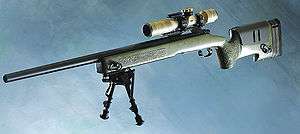Sniper equipment
The major components of sniper equipment are the sniper rifle, ammunition and camouflage.
Sniper rifles
Historic military sniper rifles up to and including the Second World War were usually based on the standard service rifle of the country in question. They included the German Mauser Gewehr 98K, U.S. M1903 Springfield and M1 Garand, Soviet Mosin–Nagant, Norwegian Krag–Jørgensen, Japanese Arisaka, and British Lee–Enfield No. 4. Models used for sniping were generally factory tested for accuracy and fitted with specialized components, including not just optics but also such items as slings, cheek pieces, and flash eliminators.
Modern sniper rifles, from the 1960s onwards, have been increasingly purpose-built. The critical goal is reliable placement of the first shot within one MOA (minute of angle). Most include special features for this purpose, including tight building tolerances and precise components. Measures are also taken to ensure the rifle is affected as little as possible by heating, vibration and other effects which may reduce accuracy. Besides that, purpose-built sniper rifle systems often offer factory made accessories like telescopic sight mounting sets, MIL-STD-1913 rails (Picatinny rails), auxiliary iron sights for emergency use, cleaning kits, muzzle brakes/flash-hiders and silencers (sound suppressors), butt plates and spacers to adjust the rear end of the rifle to the shooter's height and angle for comfort and length of pull, monopods (buttspikes), bipods, handstops, mirage bands, soft and heavy-duty transit cases and various maintenance tools. An example of a non-factory-made accessory could be shooting sticks that can be employed as rifle field rest.
Common modern sniper rifles, such as M24 and L96 are widely used by sniper teams. The importance of using anti-material rifle was also considered during World War II .
Ammunition
Most snipers are issued with specially developed and manufactured match-grade military ammunition. This ammunition is typically manufactured to highly exacting tolerances and therefore provide improved accuracy over standard military ammunition.
This ammunition often features a boat-tail (narrowing at the base end), because it provides better ballistic performance due to the reduced air resistance (drag).
Though target shooters often assemble their own ammunition from components to more precisely control the load and tune it to the specific rifle and task, this is practically unknown in military and police circles as this may interfere with various laws.
Ideally, a shooter would acquire rounds from a single lot or batch of manufactured ammunition, zero the rifle to that lot, and then use only that ammunition until it runs out. This ensures that every bullet is as similar as possible to the previous one, and assists consistency. However, this is rarely practicable. A sniper will enter information into a Data On Previous Engagement (DOPE) book, such as lot number, temperature, wind speed/direction, humidity and altitude. If the same conditions are encountered again, the data is available to assist in making an accurate shot. Most information gathering must start over if the barrel is replaced, as each barrel has distinct characteristics.
Velocity of a sniper bullet
Sniper rifles generally project bullets at the same velocities employed by general-purpose firearms. However, they often use projectiles that are very aerodynamic, with particularly high ballistic coefficients.
Depending on the rifle, bullets typically travel between 800 and 1000 m/s (2600 and 3400 feet per second) at the moment they leave the rifle's barrel. The bullet slows down considerably due to friction with the air over a distance. The distance a bullet will travel is determined by its shape, weight, launch velocity and launch angle as with any projectile, the study of which is referred to as external ballistics.
In sniping, it is generally considered essential that the bullet still be traveling at a supersonic speed by the time it reaches the target, because accuracy is compromised when a bullet's velocity enters the transonic speed region. In the case of the typical 7.62 × 51 mm NATO (.308 Winchester) sniping round, this equates to a maximum theoretical range of about 800 meters.[1]
Example
Here below is how a 10-gram (155 gr) Lapua Scenar 7.62×51mm NATO / .308 Winchester load [2] performs from 0 m to 1400 m out of a rifle at 860 m/s muzzle velocity under ICAO Standard Atmosphere conditions at sea level (air density ρ = 1.225 kg/m³ and the speed of sound = 340.39 m/s):
| Range (m) | 0 | 100 | 200 | 300 | 400 | 500 | 600 | 700 | 800 | 900 | 1000 | 1100 | 1200 | 1300 | 1400 |
|---|---|---|---|---|---|---|---|---|---|---|---|---|---|---|---|
| Velocity (m/s) | 860 | 797 | 737 | 678 | 623 | 569 | 518 | 470 | 423 | 381 | 342 | 317 | 297 | 282 | 270 |
| Energy (J) | 3698 | 3177 | 2712 | 2301 | 1938 | 1620 | 1343 | 1103 | 896 | 724 | 586 | 501 | 442 | 398 | 364 |
Conversely, slower subsonic bullet velocities might be desirable at close ranges because it will drastically reduce the sound or noise generated by the bullet (and rifle), especially when the rifle is also fitted with a sound suppressor (commonly known as "silencers"). This would help the sniper to remain concealed or undetected.
The terminal ballistics of a bullet is also an important factor limiting the range in which it can be used effectively and is determined, in part, by its velocity. This is because a certain minimum amount of the kinetic energy is deemed necessary to be effective (the amount varies with the target and the type of bullet). This kinetic energy is a factor of the bullet's weight and velocity and as such will decrease as the velocity of the bullet decreases. So while the bullet might still strike the target, it might not carry enough kinetic energy to be effective. This effective distance can be extended by the use of armor-piercing ammunition, because even though this type of bullet will typically carry the same kinetic energy as an ordinary bullet, it has a greater penetrative effect by virtue of its design and hence would still be effective. This is an important consideration in the case of a sniper, where an armor-piercing bullet would penetrate a helmet or ballistic vest ("bullet-proof vest") at ranges where an ordinary bullet would no longer be able to penetrate it.
Camouflage

Snipers employ camouflage and limit their movements in order to avoid detection.
Special care has to be taken with the telescopic sight, because the front lens cannot be fully covered and is made of a highly reflective surface (normally polished glass) off which the glare of the sun can easily reflect, drawing attention to the sniper's position. Common solutions are to avoid exposure to direct sunlight by taking up a position in a shaded area or by cover the lens in non-reflective materials (some type of duct tape, fabric or metal mesh) leaving only a small slit to see through.
Snipers also have to take into account their appearance under infrared (IR) light, because many armed forces now employ thermal vision devices that work in this spectrum of light as opposed to normal night vision devices that simply gathers and intensifies normal light. Some clothes or equipment stand out when viewed with thermal vision devices and care has to be taken in selecting and covering equipment so that the sniper is not readily visible when viewed under infrared light. Clothing or equipment not readily visible under infrared light is said to have a "low IR signature". Plastic or foil "thermal blankets" can also be employed to cover a sniper and their equipment, but these in turn must then be camouflaged (often local foliage or material).
Ghillie suit
Snipers with extreme requirements for infiltration and camouflage use a ghillie suit. The ghillie suit was originally developed by Scottish game wardens to better count game and catch poachers.
Ghillie suits can be constructed in several different ways. Some services make them of rough burlap (of the hessian kind) flaps attached to a net punch. U.S. Army ghillie suits are often built using a pilot's flight suit, or some other one-piece coverall as the base. A full cover of rough webbing or fishnetting in a durable fabric is attached in irregular patterns designed to hide lines and blend in. Then, this is weathered using mud, by dragging it under or running over it with a car. When on location, as much of the local foliage as possible without restricting movement is applied to blend in. It is customary for the ghillie suit to be made by the sniper, rather than bought.
An inherent problem with ghillie suits is internal temperatures. Even in relatively moderate climates, the temperature inside of the ghillie suit can soar to over 50 °C (120 °F).
Main components

Sniper gear or equipment is broken up to three branches: weapons, optics, and communications. Items commonly carried by military or police snipers include: • Rifle + Ammunition • Hand held Radio • Knife • Binoculars • Compass/GPS • Canteen or Water bladder • Whistle • Insect Repellent • Mini Thermometer • Food rations • First aid items • Ear Protection • Penlight w/ Filter • Chemical Mace • Camouflage Paste • Strobe Light • Pencil & Notebook • Laser Rangefinder
Communications
The sniper and spotter must have a communication link for communication with each other and with friendly forces. Indeed, communication tools are the most common equipment carried by both military and police snipers.
Optics
The sniper and spotter use a wide variety of optics, such as the sniper scope, the spotter scope, field glasses (binoculars) and laser rangefinders.
Notes
- ↑ Sniper rifle: Maximum effective range
- ↑ The 7.62 mm 10-gram Lapua Scenar is one of the best long-range, high-accuracy bullets available for 7.62×51mm NATO rifles. It starts to enter the transonic region around 800 m and gets subsonic around 1000 m.
Further reading
- " Snipers, tireurs d'élite et armes de précision du monde " Edition Mission Spéciale Production. 2006 *
- Plaster, Maj. John (1993). The Ultimate Sniper: An Advanced Training Manual for Military & Police Snipers. Paladin. ISBN 0-87364-704-1.
- Law, Clive M. (2005). Without Warning: Canadian Sniper Equipment. Service Publications. ISBN.
- Brooksmith, Peter (2000). Sniper: Training, Techniques and Weapons. St. Martin's Press. ISBN 0-312-26098-9.
External links
- Snipercentral.com
- PRACTICAL LONG-RANGE RIFLE SHOOTING - PART I: THE RIFLE & GEAR
- PRACTICAL LONG-RANGE RIFLE SHOOTING - PART II: OPTICS
- PRACTICAL LONG-RANGE RIFLE SHOOTING - PART III: SHOOTING

